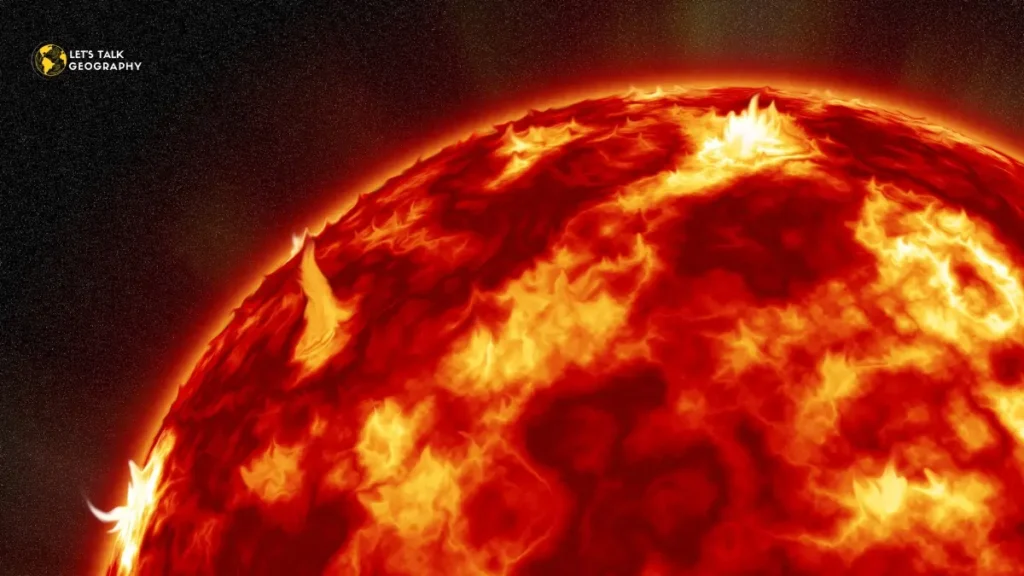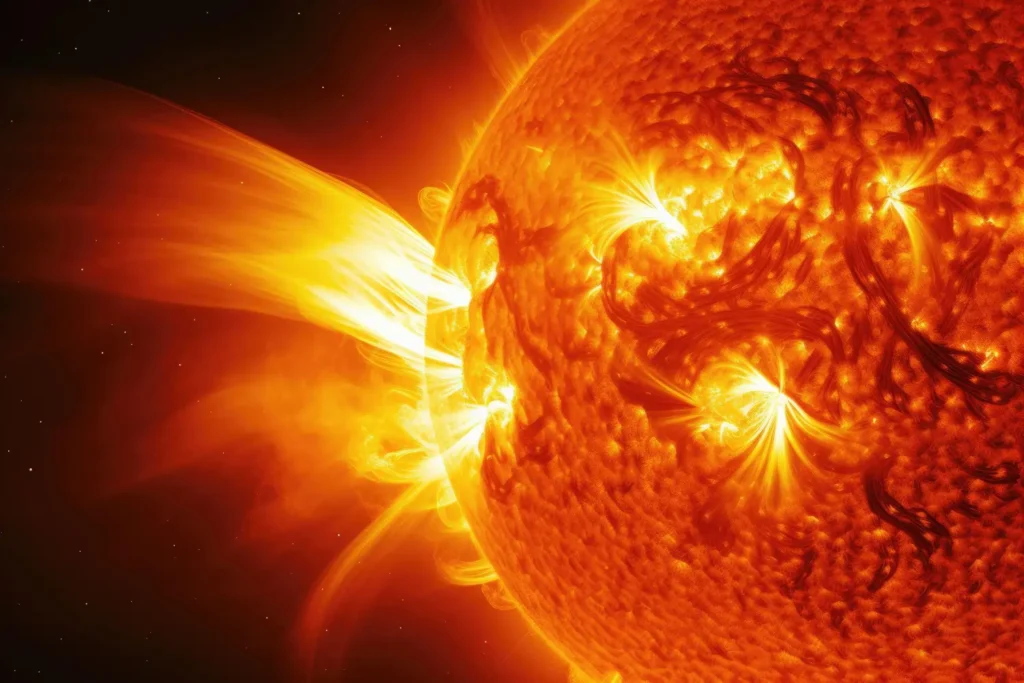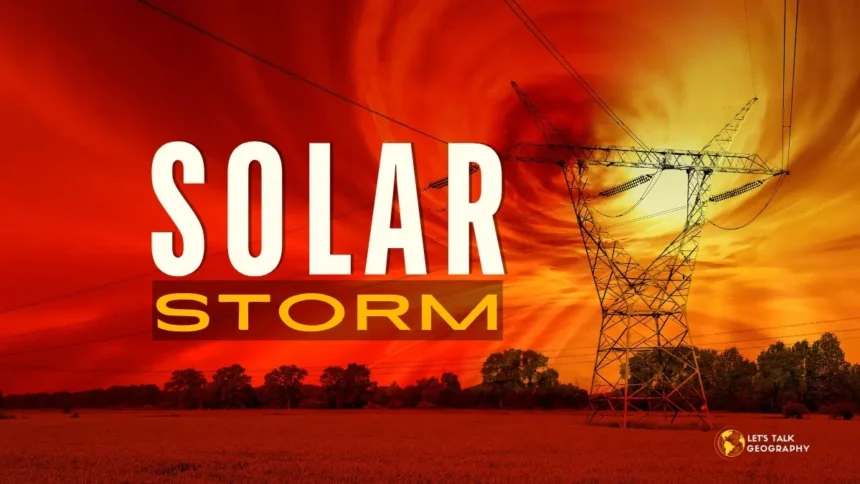Introduction:
Imagine a powerful natural phenomenon that can disrupt satellite communications, affect power grids, and create breathtaking auroras. This phenomenon is known as a solar storm.
This article delves into solar storms, their causes and effects, and the importance of monitoring and understanding these celestial events. Understanding solar storms is vital for preparing and protecting our technological infrastructure and appreciating the fascinating interplay between the sun and our planet. I was delving deep into the meaning of a solar storm, its causes, potential impacts on Earth, historical instances, and current scientific efforts to predict and mitigate its effects.
Components of the Solar System:
Planets and Their Characteristics:
Our solar system includes eight planets: Mercury, Venus, Earth, Mars, Jupiter, Saturn, Uranus, and Neptune.
Planets are round and opaque celestial bodies that move around the sun in a round orbit. They move on their own axis. They also move around the sun and are bright like stars.
Other Celestial Bodies:
Celestial bodies are objects like the sun, moon, planets, and stars with high gravitational attraction.
What is a Solar Storm?
A solar storm is a burst of solar wind and magnetic fields from the sun that impacts Earth’s magnetosphere. These cosmic events can disrupt satellites, power grids, and communications. Understanding solar storms helps us prepare for their potential effects on our modern technology and daily lives.

Definition and Characteristics:
Solar Flares are enormous explosions appearing on the surface of the Earth. They include coronal mass ejections (CMEs), accumulated charged particles, and giant bubbles of coronal plasma mixed with vast amounts of magnetic field lines reflected from the sun. The sun’s magnetic field detects solar energy through solar wind activities. These energetic particles disrupt the magnetic field, justified as geomagnetic storms or substorms. Interpretation of these events is very important for understanding the more significant influences of the solar system and the Milky Way galaxy related to what a Solar storm is.
Causes of Solar Storms:
- Solar radiation appears in high-energy particles and is emitted into space by large-scale magnetic eruptions. It appears in the solar system and is a reason for coronal mass ejection and linked solar flares, raising the pace of charged particles in the solar atmosphere to excessive velocities. This influences the earth’s magnetic field and is essential in understanding solar storms.
- Coronal mass Injections are massive plasma dismissals and a magnetic field from the Sun’s corona. They emit billions of tons of coronal material and use an embedded magnetic field more powerful than any solar wind interplanetary magnetic field strength.CMEs go outward from away from the sun at apace, ranging from 250 kilometers per second to faster to 3000 kmm/s. The fastest earth-directed CMEs can go to Earth in as little as 15-18 hours.
Impacts of Solar Storms on Earth:
Sun’s Role in Solar Storms:
The sun, which has a diameter of nearly 865000 miles (1.4 million kilometers), is also the most massive object in the solar system. It has a gravitational attraction that keeps the whole solar system intact, making sure that all the giant planets, including the minute debris that revolves around it, remain intact. This gravitational force influences the Earth and all other celestial bodies within the Milky Way Galaxy, affecting their position and connections. Interpreting the sun’s role is crucial while investigating the occurrence of “earth’s Magnetic field” and bringing up the queries related to “What is a solar Storm?”

Technological Disruption:
- Satellite Communications: The geomagnetic storms that cause the auroras can also negatively impact human-made configurations. These storms happen due to substantial energy particles from the Sun striking the atmosphere, which can block out electrical grids and satellites. This even leads to magnetic solid fluctuations at the surface of the Earth, soaking up particular radio frequencies. The subatomic particles emitted from solar storms caused by these CMEs can harm solar panels and satellite electronics. Flare activity in conjunction with radio blackouts can interfere with radio communications’ powerful frequency.
- Power Grid: Satellites also get influenced, declining operations and communications services on Earth. As per NOAA, the links and connections between GPS satellites and ground receivers may stay disrupted and even get lost after the storm passes.
Effects on Earth’s Magnetic Field:
Considering the two most extensive solar flare classes, things get more interesting. M-mighty and X-class flares can influence coronal mass ejections and the particular release of plasma and magnetic fields from the s. This activity can degrade Earth’s magnetic fields, resulting in geomagnetic storms. These storms appear nearer to the equator, mainly during calm solar conditions.
- Disruption of Communication Systems: Specific radio frequencies are absorbed during geomagnetic storms while others are reflected, causing rapidly fluctuating signals and unexpected propagation paths. Signals reproduce or multiply in unplanned directions, often disrupting public and amateur radio communications.
- Impact on Power Grids: Satellites can also be impacted, potentially disrupting navigation and communication services on Earth. According to NOAA, signals between GPS satellites and ground receivers may remain scrambled or lost even after the storm has passed.
Potential Threats to Earth:
- Effects on Satellites: Solar plasma from a geomagnetic storm heated the atmosphere, causing denser gases to expand into the satellites’ orbit. This increased atmospheric drag on the satellites, leading to their de-orbit.
- Implications for Astronauts: Extremely high-energy particles, such as those transported by CMEs, can lead to radiation poisoning in humans and other mammals. These particles present a severe risk to astronauts without proper shielding, especially those on missions to the Moon or Mars, where large doses could be lethal.
Notable Solar Storm Events:
- The Carrington Event (1859): It was a massive solar storm in September 1859, just a few months before the maximum of 1860. This flare was a significant coronal mass ejection, releasing magnetized plasma from the Sun’s upper atmosphere, the corona. In 17.6 hours, The CME traveled over 90 million miles between the Sun and Earth and released its force on Earth.
- The Halloween Storms (2003): In 2003, the sun released an unusual chain of solar flares called “Halloween solar effects. The intense on-beam flares bombarded the sun’s surface on Oct 28, introducing a high-speed burst of electrically charged particles. i.e., Coronal Mass ejection.
Monitoring and Predicting Solar Storms:
Extreme Ultraviolet and X-ray irradiance help discover solar flares and monitor solar irradiance that affects the upper atmosphere. Solar irradiance is the strength and affects the sun’s electromagnetic radiation per unit area. The X-ray Sensor (XRS) monitors the Earth’s upper atmosphere and helps discover solar proton events that can penetrate Earth’s magnetic fields.
Current Scientific Efforts:
- Role of Space Agencies: Space agencies are essential in monitoring solar storms by placing satellites and other space probes during solar activities. They provide caution and forecasts by safeguarding Earth’s satellites, power grids, and communication systems from the harmful effects caused by solar storms.
- Predictive Models: Technical models like the Solar and Heliospheric Observatory (SOHO) predict solar weather in real-time, thus improving the safeguarding of technological architectures.
Conclusion:
Solar storms, also known as geomagnetic storms, are significant cosmic events that can profoundly impact our planet. By understanding solar storms and their causes, such as solar flares and coronal mass ejections, we can better appreciate the complexity of our solar system. Their potential to disrupt modern technology, from satellite communications to power grids, highlights the relevance of solar storms, emphasizing the importance of monitoring these phenomena.
Exploring the historical context and current scientific efforts to predict and mitigate their effects underscores the necessity of this knowledge. Grasping the concept of solar storms enriches our understanding of Earth’s magnetic field and our place within the larger Milky Way Galaxy. This foundational insight sets the stage for a deeper exploration of the captivating and critical subject of solar storms.
References:
- Beck, S. (n.d.). Space Technology 5. Nasa.gov. Retrieved May 24, 2024, from https://www.jpl.nasa.gov/nmp/st5/SCIENCE/storms.html
- What is a solar storm? (n.d.). Wonderopolis.org. Retrieved May 24, 2024, from https://www.wonderopolis.org/wonder/what-is-a-solar-storm/
- Solar radiation storm. (n.d.). Noaa.gov. Retrieved May 24, 2024, from https://www.swpc.noaa.gov/phenomena/solar-radiation-storm
- Sun: Facts – NASA science. (2017, November 14). Nasa.gov. https://science.nasa.gov/sun/facts/
- Josh, J. (2012, August 16). Sun and its interactions with the Earth and the solar system. Jagran Josh. https://www.jagranjosh.com/general-knowledge/sun-and-its-interactions-with-the-earth-and-the-solar-system-1345102366-1
- What are planets? State any four planet characteristics (2022, July 4). Byjus.com; BYJU’S. https://byjus.com/question-answer/what-are-planets-state-any-four-characteristics-of-a-planet/
- Dobrijevic, D. (2022, May 17). Solar flares: What are they, and how do they affect Earth? Space.com; Space. https://www.space.com/solar-flares-effects-classification-formation
- Celestial bodies. (2018, May 29). BYJUS; BYJU’S. https://byjus.com/physics/celestial-bodies/
- Beck, S. (n.d.). Space Technology 5. Nasa.gov. Retrieved May 24, 2024, from https://www.jpl.nasa.gov/nmp/st5/SCIENCE/storms.html
- Srivastava, A. (2024, May 11). A powerful solar storm hits Earth and may disrupt power grids and communication. Know its impact on India. Latest News, Breaking News, LIVE News, Top News Headlines, Viral Video, Cricket LIVE, Sports, Entertainment, Business, Health, Lifestyle and Utility News | India.com. https://www.india.com/science/powerful-solar-storm-hits-earth-may-disrupt-power-grids-communication-know-its-impact-on-india-6919993/
- Christensen, A. J., & Merkin, S. (2023, December 11). NASA Scientific Visualization Studio. NASA Scientific Visualization Studio. https://svs.gsfc.nasa.gov/5193/
- Coronal mass ejections. (n.d.). Noaa.gov. Retrieved May 25, 2024, from https://www.swpc.noaa.gov/phenomena/coronal-mass-ejections
- Byrd, D. (2024, March 18). Are solar storms dangerous to us on Earth? EarthSky | Updates on Your Cosmos and World; EarthSky. https://earthsky.org/space/are-solar-storms-dangerous-to-us/
- How NASA tracked the most intense solar storm in decades. (2024, May 16). Nasa.gov. https://science.nasa.gov/science-research/heliophysics/how-nasa-tracked-the-most-intense-solar-storm-in-decades/
- PTI. (2024, May 16). Explained. Deccan Herald. https://www.deccanherald.com/science/explained-how-solar-storms-that-caused-pretty-auroras-can-create-havoc-with-technology-3025187
- Baker, H. (2023, October 29). Historic space photo: A monstrous “Halloween storm” explodes from the sun. Live Science. https://www.livescience.com/space/the-sun/historic-space-photo-a-monstrous-halloween-storm-explodes-from-the-sun





